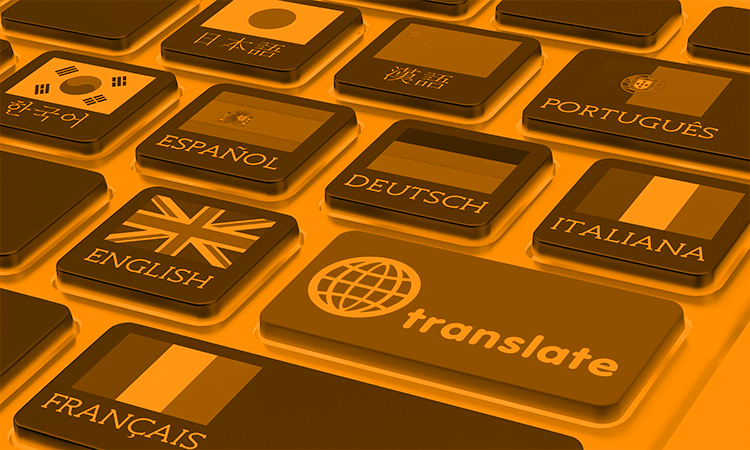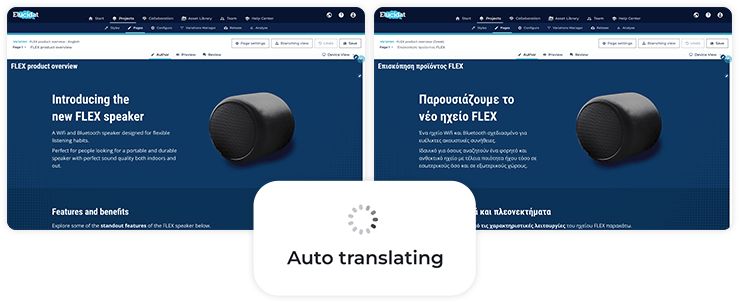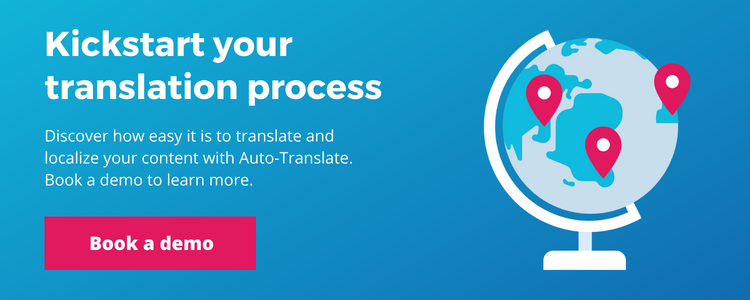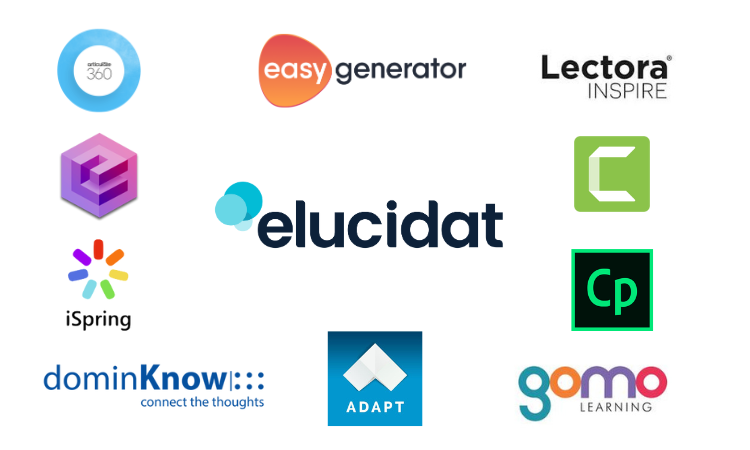Elearning translation: tools, services, and tips for success
6 minute read
When it comes to maximizing your reach and improving your impact, it pays off to speak your learners’ language. But there’s more to producing effective global learning content than just translating the words. Whether you’re tackling translation with automated tools or reaching out to professional services, our guide to elearning translation will set you up for success.

What is elearning translation?
Elearning translation means converting a digital learning course from its original language into a target language. Sounds straightforward, right? But it’s rarely as simple as just swapping out one piece of text with another.
Whether it’s animation or audio, elearning can contain a lot of multimedia content that’s trickier to translate. Rather than translating once, you may need to create different language versions. And with different languages comes different cultural contexts. A quick translation task can turn into a complex multilingual elearning project.
The significance of elearning translation
While elearning translation can be complicated, when done well, it brings major benefits.
Increased access: Even if your employees are bilingual, using your learners’ native language makes your training far more accessible. By translating your elearning, you’re really catering for your global audience.
Cultural relevance: Don’t let cultural barriers get in the way of effective learning. Translate and localize your elearning materials to address regional nuances. Make the learning truly relevant to your audience.
Improved results: Effective translations and localization ensures the comprehension of all learners. When your learners can understand and relate to your digital content, they’re more likely to remember and apply it.
Elearning translation & localization
A combination of translation and localization is key to maximizing the impact of your elearning. So, what’s the difference between these two terms?
Translation means replacing words in one language with equivalent ones in another language. The aim is to convey the same meaning. The content is adapted, but only at the linguistic level. This can mean the foreign feel of the original text is maintained.
Localization encompasses translation and more. It involves reshaping your elearning to meet the needs of a specific regional audience and deliver on your original learning objectives. It focuses on local requirements (such as laws) and cultural nuances (for example, changing metaphors that won’t translate).
Elearning translation tools and services
There are many ways to tackle elearning translation and localization. Two common approaches involve either using:
- Automated elearning translation tools
- Elearning translation services
Let’s take a closer look at each of these and why you might use them.
Automated elearning translation tools
Automated translation software enables you to simplify the entire translation process. It uses Artificial Intelligence (AI) to quickly deliver translated learning content.
Benefits:
- Quick and easy: Reduce the time and effort it takes to translate your elearning content. Have a draft translation at the click of a button.
- Cost effective: By automating the bulk of the translation effort, translation software reduces dependency on expensive translation services.
Limitations:
- Accuracy: Although the tech is always improving, errors can slip in when using automated translation. The output needs to be reviewed to ensure accuracy.
- Cultural context: If you’re looking to avoid cultural confusion, don’t rely on automated translation tools alone. You need a local expert to check the translated elearning materials are relevant.
Examples:
- DeepL Translator offers accurate and nuanced machine translation for 31 languages. DeepL prides itself on its tool’s ability to translate even the slightest nuances. The output of this tool needs to be reengineered within your chosen authoring tool.
- Elucidat – Auto-Translate integrates machine translation with an elearning authoring tool. Choose your source language and translate content into one of 75 languages. Translated versions can then be managed centrally. You can make global changes in one place, and they’ll instantly feed through into all versions.

Elearning translation services
Elearning translation companies can offer a range of support – from translation only to complete reengineering. This professional touch can smooth even the most complicated translation processes.
Benefits:
- Quality: Professional translation stands out because of the skilled team that carries out the translation, including Quality Assurance (QA).
- Cultural nuance: In-country linguists will not only ensure an accurate translation, but suggest alterations that make your content more impactful with its regional audience.
- Elearning specialization: Experienced elearning localization engineers and instructional designers make sure your translated elearning course functions correctly and meets its objectives.
Limitations:
- Time consuming: Using professional translation services can take time as you’re bound by the provider’s timescales and you won’t be their only client.
- Expensive: The quality professional service these providers offer comes with a price tag. Making updates may also involve additional costs.
Examples:
- Ulatus provides high quality translations and localization of elearning materials into over 50 languages. Working with high quality linguists, localization engineers, multimedia and instructional designers, they ensure courses meet learning objectives.
- Stepes offers elearning and Learning Management System (LMS) translation solutions in all languages. With a team of professional translators, Subject Matter Experts (SMEs), multilingual voice-over talents, and multimedia production specialists, they can deliver on your elearning translation needs.
Elearning translation in action
With over 2,500 stores in 105 countries, and more than 5,000 employees, MaxMara understands the importance of global learning content. Since 2018, they’ve used Elucidat to provide high quality and relevant elearning to their employees. As well as delivering elearning to their 10 brands in their brand styling, MaxMara translate their courses into 10 languages. This means they’re able to serve their global audience with the right visuals in their local language.
To find out more about how they did this, read the full MaxMara story.
5 tips for making the right choice
Want to create a similar translation success story at your organization? Here are our 5 tips for choosing the right approach for your elearning translation projects.
- Focus on your needs
The most effective elearning translation starts in a project’s early stages. Get clear on your objectives. Define your audience. Consider localized learning needs, as well as languages.
- Identify your approach
Determine how you can best use your resources and budget to meet your project’s needs. Be open to different approaches. Using an automated tool or a professional service could be appropriate depending on your project priorities.
- Assess accuracy
Whether you’re using a tool or service, you need to check accuracy. If you’re confident in your translation service provider’s QA, this could be a spot check. Less confident or using a tool? A native speaker should review each language version to ensure accuracy.
- Test and iterate
Once you’re happy with the quality, test the translations on sample audiences. Assess and implement their feedback. Iterate until you’re happy with the end result.
- Future proof
Remember, once your initial translation project is over it’s not the end of the story. Your translations may require updates. There may be further translations. Stay up to date with the evolving translation landscape (including machine learning and AI in elearning).
Summary
Effective elearning translation and localization solutions are key to delivering truly accessible, relevant and impactful global digital learning.
If you’re going to achieve this, you need to choose the right elearning translation strategy. This starts with your project’s requirements. It’s about balancing time, resources and budget to best meet your learning objectives. Elearning translation providers offer a quality professional service, but can be costly and time consuming. In contrast, automated translation tools will save you time and money. Whichever approach you take, it’s critical your translations are reviewed and tested to ensure that they are accurate and effective.
Make elearning translation easy with Elucidat
Looking to improve your translation process? Auto-Translate could reduce the effort it takes to translate your elearning content, dramatically. Courses translated using this feature can simply be reviewed for minor adjustments rather than outsourcing the whole translation, saving time and money.
Find out more about Auto-Translate and try it for yourself by booking a demo to get started with a free trial.





